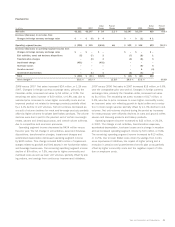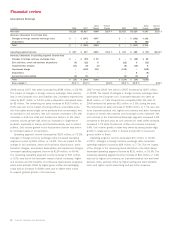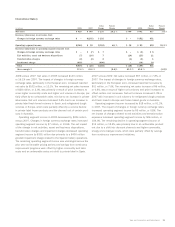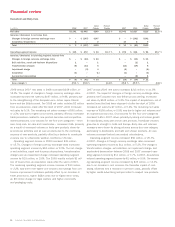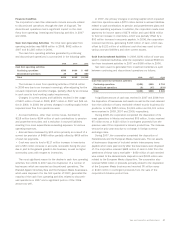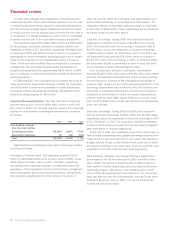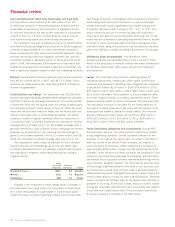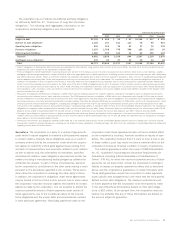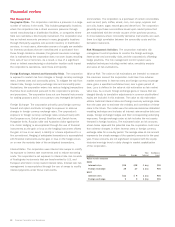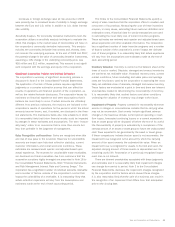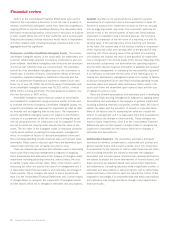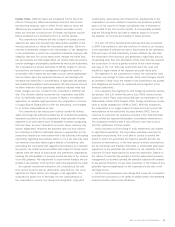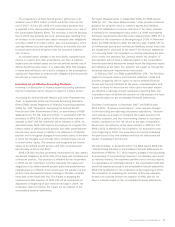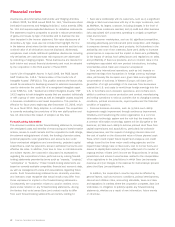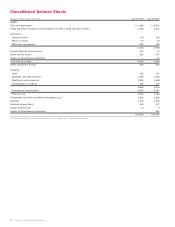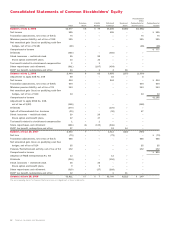Sara Lee 2008 Annual Report Download - page 34
Download and view the complete annual report
Please find page 34 of the 2008 Sara Lee annual report below. You can navigate through the pages in the report by either clicking on the pages listed below, or by using the keyword search tool below to find specific information within the annual report.
Financial review
Risk Management
Geographic Risks The corporation maintains a presence in a large
number of nations in the world. This includes geographic locations
where the corporation has a direct economic presence through
owned manufacturing or distribution facilities, or companies where
Sara Lee maintains a direct equity investment. The corporation also
has an indirect economic presence in many geographic locations
through third-party suppliers who provide inventory or distribution
services. In most cases, alternative sources of supply are available
for inventory products that are manufactured or purchased from
these foreign locations. However, the general insurance coverage
that is maintained by the corporation does not cover losses resulting
from acts of war or terrorism. As a result, a loss of a significant
direct or indirect manufacturing or distribution location could impact
the corporation’s operations, cash flows and liquidity.
Foreign Exchange, Interest and Commodity Risks The corporation
is exposed to market risk from changes in foreign currency exchange
rates, interest rates and commodity prices. To mitigate the risk from
interest rate, foreign currency exchange rate and commodity price
fluctuations, the corporation enters into various hedging transactions
that have been authorized pursuant to the corporation’s policies
and procedures. The corporation does not use financial instruments
for trading purposes and is not a party to any leveraged derivatives.
Foreign Exchange
The corporation primarily uses foreign currency
forward and option contracts to hedge its exposure to adverse
changes in foreign currency exchange rates. The corporation’s
exposure to foreign currency exchange rates exists primarily with
the European euro, British pound, Brazilian real, Danish krone,
Hungarian forint, Russian ruble and Australian dollar against the
U.S. dollar. Hedging is accomplished through the use of financial
instruments as the gain or loss on the hedging instrument offsets
the gain or loss on an asset, a liability or a basis adjustment to a
firm commitment. Hedging of anticipated transactions is accomplished
with financial instruments as the gain or loss on the hedge occurs
on or near the maturity date of the anticipated transactions.
Interest Rates
The corporation uses interest rate swaps to modify
its exposure to interest rate movements and to reduce borrowing
costs. The corporation’s net exposure to interest rate risk consists
of floating-rate instruments that are benchmarked to U.S. and
European short-term money market interest rates. Interest rate risk
management is accomplished through the use of swaps to modify
interest payments under these instruments.
Commodities
The corporation is a purchaser of certain commodities
such as beef, pork, coffee, wheat, corn, corn syrup, soybean and
corn oils, butter, sugar, natural gas and diesel fuel. The corporation
generally buys these commodities based upon market prices that
are established with the vendor as part of the purchase process.
In circumstances where commodity derivative instruments are used,
there is a high correlation between the commodity costs and the
derivative instrument.
Risk Management Activities The corporation maintains risk
management control systems to monitor the foreign exchange,
interest rate and commodity risks, and the corporation’s offsetting
hedge positions. The risk management control system uses
analytical techniques including market value, sensitivity analysis
and value at risk estimations.
Value at Risk
The value at risk estimations are intended to measure
the maximum amount the corporation could lose from adverse
market movements in interest rates and foreign currency exchange
rates, given a specified confidence level, over a given period of
time. Loss is defined in the value at risk estimation as fair market
value loss. As a result, foreign exchange gains or losses that are
charged directly to translation adjustments in common stockholders’
equity are included in this estimate. The value at risk estimation
utilizes historical interest rates and foreign currency exchange rates
from the past year to estimate the volatility and correlation of these
rates in the future. The model uses the variance-covariance statistical
modeling technique and includes all interest rate-sensitive debt and
swaps, foreign exchange hedges and their corresponding underlying
exposures. Foreign exchange value at risk includes the net assets
invested in foreign locations. The estimated value at risk amounts
shown below represent the potential loss the corporation could incur
from adverse changes in either interest rates or foreign currency
exchange rates for a one-day period. The average value at risk amount
represents the simple average of the quarterly amounts for the past
year. These amounts are not significant compared with the equity,
historical earnings trend or daily change in market capitalization
of the corporation.
Time Confidence
In millions Amounts Average Interval Level
Value at risk amounts
2008
Interest rates $16 $18 1 day 95%
Foreign exchange 35 27 1 day 95%
2007
Interest rates $11 $÷9 1 day 95%
Foreign exchange 991day 95%
32 Sara Lee Corporation and Subsidiaries



